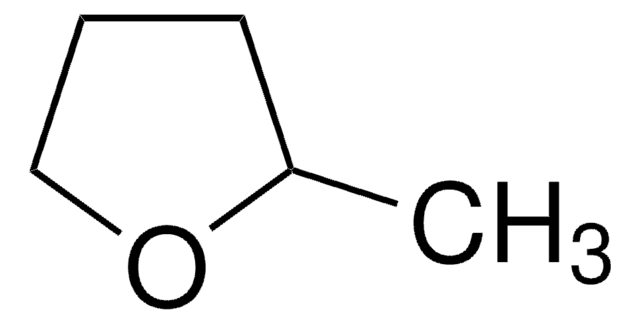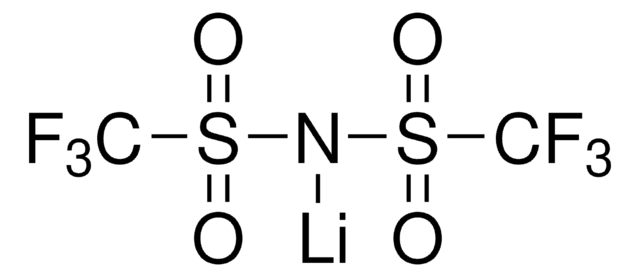271020
1,3-Dioxolane
anhydrous, contains ~75 ppm BHT as inhibitor, 99.8%
동의어(들):
Ethylene glycol methylene ether, Formaldehyde ethylene acetal
로그인조직 및 계약 가격 보기
모든 사진(3)
About This Item
실험식(Hill 표기법):
C3H6O2
CAS Number:
Molecular Weight:
74.08
Beilstein:
102453
EC Number:
MDL number:
UNSPSC 코드:
12352005
PubChem Substance ID:
NACRES:
NA.21
bp:
75-76 °C/1.013 hPa
vapor pressure:
70 mmHg ( 20 °C)
추천 제품
Grade
anhydrous
Quality Level
vapor density
2.6 (vs air)
vapor pressure
70 mmHg ( 20 °C)
분석
99.8%
양식
liquid
autoignition temp.
525 °F
포함
~75 ppm BHT as inhibitor
불순물
<0.003% water
<0.005% water (100 mL pkg)
증발 잔류물
<0.0005%
refractive index
n20/D 1.401 (lit.)
bp
75-76 °C/1.013 hPa
mp
−95 °C (lit.)
density
1.06 g/mL at 25 °C (lit.)
SMILES string
C1COCO1
InChI
1S/C3H6O2/c1-2-5-3-4-1/h1-3H2
InChI key
WNXJIVFYUVYPPR-UHFFFAOYSA-N
유사한 제품을 찾으십니까? 방문 제품 비교 안내
일반 설명
1,3-dioxolane is a heterocyclic acetal that is commonly used as a green solvent in formulations and production processes. It is also used as a reactant in organic synthesis. Long-term storage of 1,3-dioxolane forms organic peroxides. This process can be suppressed by adding butylated hydroxytoluene (BHT) as a stabilizer. BHT removes the free radicals required for peroxide formation.
애플리케이션
1,3-dioxolane can be used as a solvent:
It is also used as a reactant to prepare quasi-solid-state poly(1,3-dioxolane) electrolyte by Sc(OTf)3 catalyzed ring-opening polymerization reactions.
- For the extraction of biodegradable poly(3-hydroxybutyrate) (PHB) from biomass.
- To produce stable dispersions of multiwalled carbon nanotubes (MWCNTs) for the synthesis of modified glassy carbon electrodes.
- To synthesize copolymers (polyoxymethylene) by cationic copolymerization of 1,3,5-trioxane in the presence of maghnite-H+ as a catalyst.
It is also used as a reactant to prepare quasi-solid-state poly(1,3-dioxolane) electrolyte by Sc(OTf)3 catalyzed ring-opening polymerization reactions.
신호어
Danger
유해 및 위험 성명서
Hazard Classifications
Eye Irrit. 2 - Flam. Liq. 2 - Repr. 1B
Storage Class Code
3 - Flammable liquids
WGK
WGK 1
Flash Point (°F)
26.6 °F - closed cup
Flash Point (°C)
-3 °C - closed cup
개인 보호 장비
Eyeshields, Faceshields, Gloves
이미 열람한 고객
1, 3-Dioxolane, tetrahydrofuran, acetylacetone and dimethyl sulfoxide as solvents for non-aqueous vanadium acetylacetonate redox-flow-batteries.
Herr T, et al.
Electrochimica Acta, 113, 127-133 (2013)
Binary electrolyte based on tetra (ethylene glycol) dimethyl ether and 1, 3-dioxolane for lithium-sulfur battery.
Chang DR, et al.
Journal of Power Sources, 112(2), 452-460 (2002)
1, 3-Dioxolane: A green solvent for the preparation of carbon nanotube-modified electrodes.
Moscoso R, et al.
Electrochemical Communications, 48, 69-72 (2014)
Claudia Sorbi et al.
ChemMedChem, 4(3), 393-399 (2009-01-20)
Conformational restriction of naftopidil proved to be compatible with binding at alpha(1) adrenoceptor subtypes and 5-HT receptor 1A (5-HT(1A)), and led to the discovery of a new class of ligands with a 1,3-dioxolane (1,3-oxathiolane, 1,3-dithiolane) structure. Compound 7 shows the
Deepak Ekka et al.
The journal of physical chemistry. B, 116(38), 11687-11694 (2012-09-04)
Precise measurements on electrical conductance (Λ) of solutions of an ionic liquid (IL) tetrabutylphosphonium tetrafluoroborate in acetonitrile (ACN), tetrahydrofuran (THF), and 1,3-dioxolane (1,3-DO) and their binary mixtures have been reported at 298.15 K. The conductance data have been analyzed by
자사의 과학자팀은 생명 과학, 재료 과학, 화학 합성, 크로마토그래피, 분석 및 기타 많은 영역을 포함한 모든 과학 분야에 경험이 있습니다..
고객지원팀으로 연락바랍니다.












